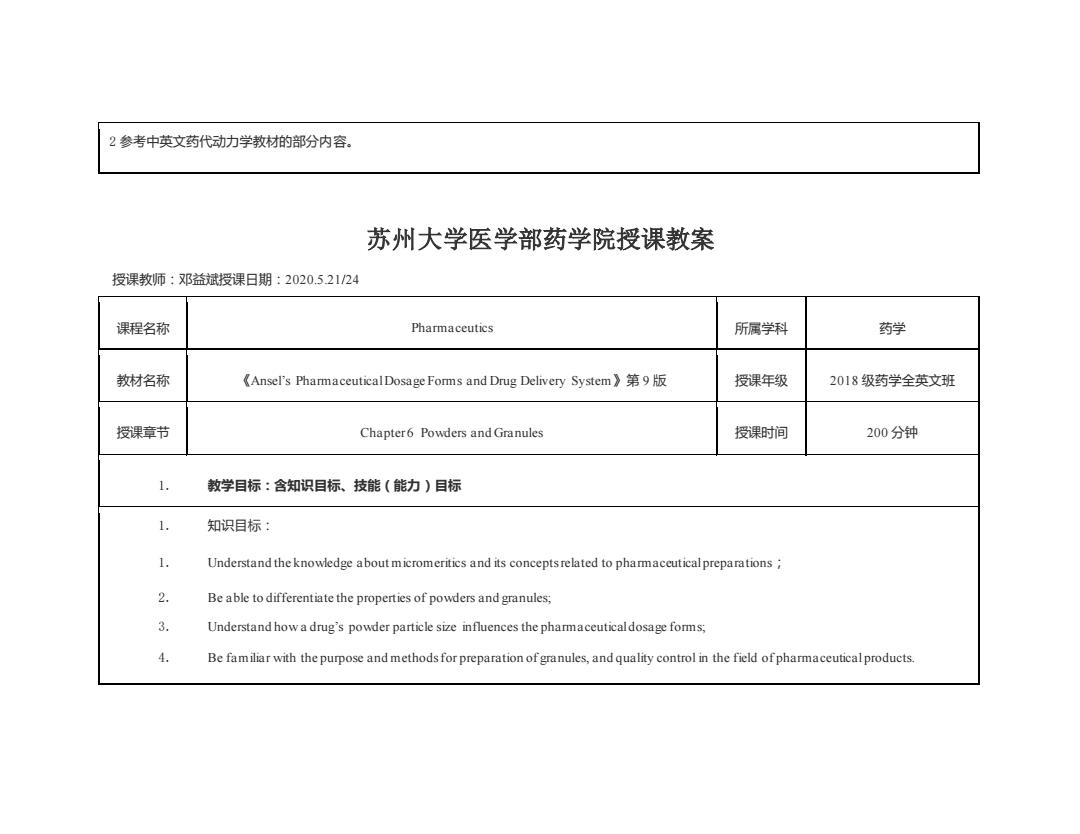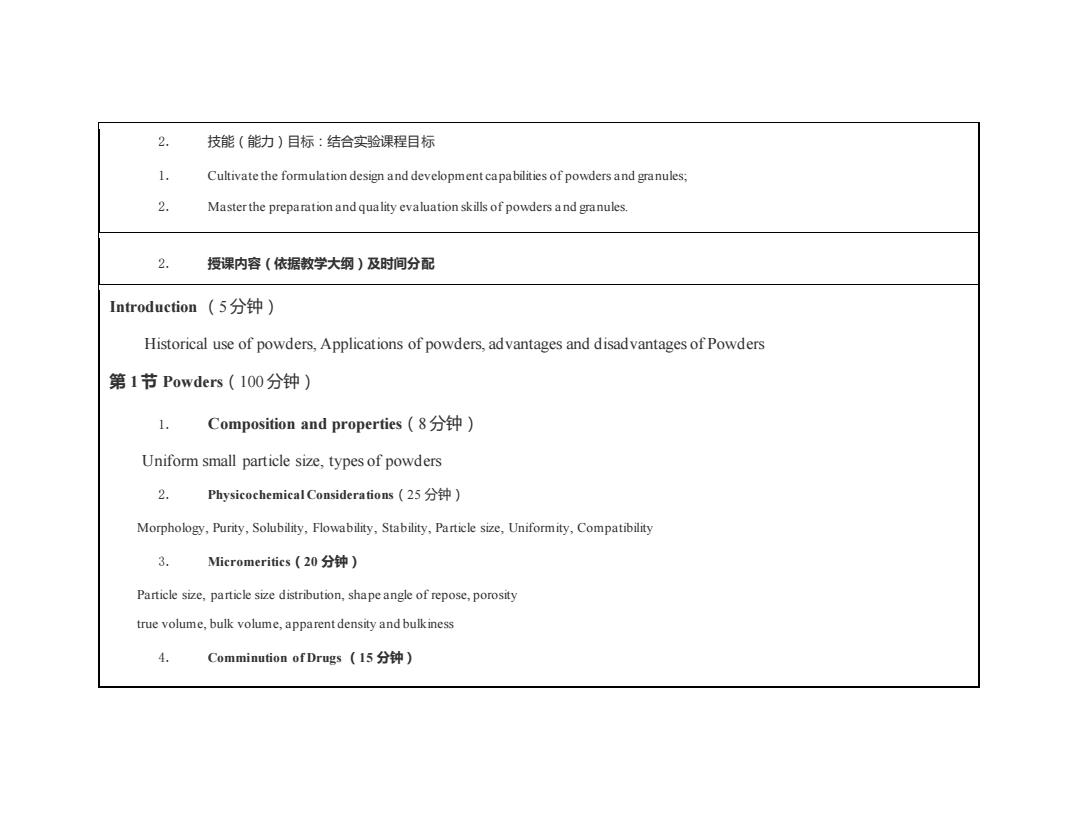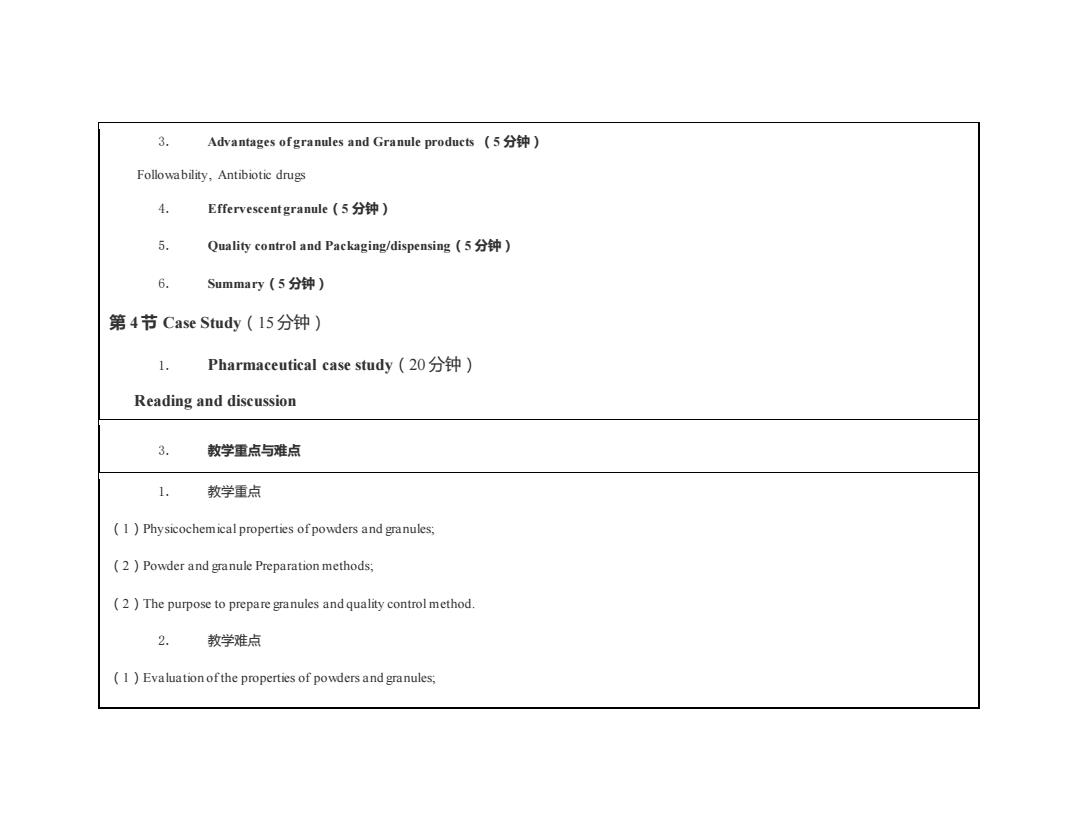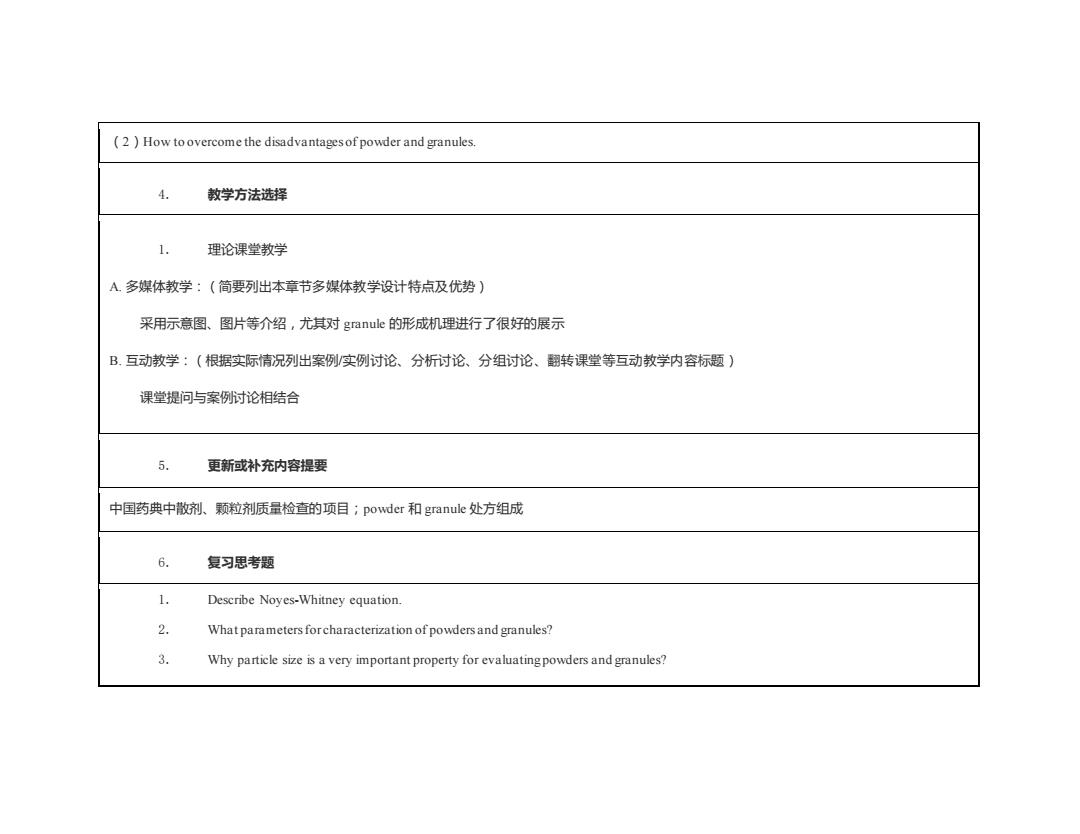
2参考中英文药代动力学教材的部分内容。 苏州大学医学部药学院授课教案 授课教师:邓益斌授课日期:2020.521/24 课程名称 Pharmaceutics 所属学科 药学 教材名称 《Ansel's PharmaceuticalDosage Forms and Drug Delivery System》第9版 授课年级 2018级药学全英文班 授课章节 Chapter6 Powders and Granules 授课时间 200分钟 1. 教学目标:含知识目标、技能(能力)目标 1. 知识目标: 1. Understand the knowledge about micromeritics and its concepts related to pharmaceuticalpreparations 2. Be able to differentiate the properties of powders and granules; 3. Understand how a drug's powder particle size influences the pharmaceuticaldosage forms; 4 Be familiar with the purpose and methods for preparation of granules,and quality control in the field ofpharmaceuticalproducts
2 参考中英文药代动力学教材的部分内容。 苏州大学医学部药学院授课教案 授课教师:邓益斌授课日期:2020.5.21/24 课程名称 Pharmaceutics 所属学科 药学 教材名称 《Ansel’s Pharmaceutical Dosage Forms and Drug Delivery System》第 9 版 授课年级 2018 级药学全英文班 授课章节 Chapter 6 Powders and Granules 授课时间 200 分钟 1. 教学目标:含知识目标、技能(能力)目标 1. 知识目标: 1. Understand the knowledge about micromeritics and its concepts related to pharmaceutical preparations; 2. Be able to differentiate the properties of powders and granules; 3. Understand how a drug’s powder particle size influences the pharmaceutical dosage forms; 4. Be familiar with the purpose and methods for preparation of granules, and quality control in the field of pharmaceutical products

2. 技能(能力)目标:结合实验课程目标 1. Cultivate the formulation design and development capabilities of powders and granules; 2. Master the preparation and quality evaluation skills of powders and granules. 2. 授课内容(依据教学大纲)及时间分配 Introduction(5分钟) Historical use of powders,Applications of powders,advantages and disadvantages of Powders 第1节Powders(100分钟) 1. Composition and properties(8分钟) Uniform small particle size,types of powders 2. Physicochemical Considerations(25分钟) Morphology,Purity,Solubility,Flowability,Stability,Particle size,Uniformity,Compatibility 3 Micromeritics(20分钟) Particle size,particle size distribution,shape angle of repose,porosity true volume,bulk volume,apparent density and bulkiness 4. Comminution of Drugs(15分钟)
2. 技能(能力)目标:结合实验课程目标 1. Cultivate the formulation design and development capabilities of powders and granules; 2. Master the preparation and quality evaluation skills of powders a nd granules. 2. 授课内容(依据教学大纲)及时间分配 Introduction (5 分钟) Historical use of powders, Applications of powders, advantages and disadvantages of Powders 第 1 节 Powders(100 分钟) 1. Composition and properties(8 分钟) Uniform small particle size, types of powders 2. Physicochemical Considerations(25 分钟) Morphology, Purity, Solubility, Flowability, Stability, Particle size, Uniformity, Compatibility 3. Micromeritics(20 分钟) Particle size, particle size distribution, shape angle of repose, porosity true volume, bulk volume, apparent density and bulkiness 4. Comminution of Drugs (15 分钟)

Tools for comminution,the purpose and the methods 5. Blending Powders(20分钟) Geometric dilution technique,methods for blending,equipment for blending,Factors in Blending 6. Special powders(I0分钟) Eutectics,Hygroscopic and Deliquescent powders,Efflorescent Powders 7.Section summary(2分钟) 第2节Medicated Powders(30分钟) 1. Powder Applications(I0分钟) Internally,Externally,Inhaled,Dentifrices,Insufflations,Powder Aerosols 2. Aerosol Powders(20分钟) Dry-powder inhalers,Example oral inhalation powders,Bulk and Divided Powders 第3节Granules(50分钟) 1. Introduction about Granules(5分钟) Internally,Externally,Inhaled,Dentifrices,Insufflations.Powder Aerosols 2. Granule Preparation(25分钟) Wet methods,dry methods,Example oral inhalation powders,Bulk and Divided Powders
Tools for comminution, the purpose and the methods 5. Blending Powders(20 分钟) Geometric dilution technique, methods for blending, equipment for blending, Factors in Blending 6. Special powders (10 分钟) Eutectics, Hygroscopic and Deliquescent powders, Efflorescent Powders 7. Section summary (2 分钟) 第 2 节 Medicated Powders(30 分钟) 1. Powder Applications(10 分钟) Internally, Externally, Inhaled, Dentifrices, Insufflations, Powder Aerosols 2. Aerosol Powders(20 分钟) Dry-powder inhalers, Example oral inhalation powders, Bulk and Divided Powders 第 3 节 Granules(50 分钟) 1. Introduction about Granules(5 分钟) Internally, Externally, Inhaled, Dentifrices, Insufflations, Powder Aerosols 2. Granule Preparation(25 分钟) Wet methods, dry methods, Example oral inhalation powders, Bulk and Divided Powders

3.Advantages ofgranules and Granule products (5) Followability,Antibiotic drugs 公 Effervescent granule(5分钟) 5. Quality control and Packaging/dispensing (5) & Summary(5分钟) 第4节CaseStudy(15分钟)】 1. Pharmaceutical case study(20分钟) Reading and discussion 3. 教学重点与难点 1. 教学重点 (1 )Physicochemical properties ofpowders and granules; (2 )Powder and granule Preparation methods; (2 )The purpose to prepare granules and quality control method. 2. 教学难点 (1 )Evaluationofthe properties of powders and granules;
3. Advantages of granules and Granule products (5 分钟) Followability, Antibiotic drugs 4. Effervescent granule(5 分钟) 5. Quality control and Packaging/dispensing(5 分钟) 6. Summary(5 分钟) 第 4 节 Case Study(15 分钟) 1. Pharmaceutical case study(20 分钟) Reading and discussion 3. 教学重点与难点 1. 教学重点 (1)Physicochemical properties of powders and granules; (2)Powder and granule Preparation methods; (2)The purpose to prepare granules and quality control method. 2. 教学难点 (1)Evaluation of the properties of powders and granules;

(2 )How toovercome the disadvantagesofpowder and granules. 4. 教学方法选择 1. 理论课堂教学 A多媒体教学:(简要列出本章节多媒体教学设计特点及优势) 采用示意图、图片等介绍,尤其对granule的形成机理进行了很好的展示 B.互动教学:(根据实际情况列出案例/实例讨论、分析讨论、分组讨论、翻转课堂等互动教学内容标题) 课堂提问与案例讨论相结合 更新或补充内容提要 中国药典中散剂、颗粒剂质量检查的项目;powder和granule处方组成 6. 复习思考题 1. Describe Noyes-Whitney equation. 2. What parameters forcharacterization of powders and granules? 3. Why particle size is a very important property for evaluatingpowders and granules?
(2)How to overcome the disadvantages of powder and granules. 4. 教学方法选择 1. 理论课堂教学 A. 多媒体教学:(简要列出本章节多媒体教学设计特点及优势) 采用示意图、图片等介绍,尤其对 granule 的形成机理进行了很好的展示 B. 互动教学:(根据实际情况列出案例/实例讨论、分析讨论、分组讨论、翻转课堂等互动教学内容标题) 课堂提问与案例讨论相结合 5. 更新或补充内容提要 中国药典中散剂、颗粒剂质量检查的项目;powder 和 granule 处方组成 6. 复习思考题 1. Describe Noyes-Whitney equation. 2. What parameters for characterization of powders and granules? 3. Why particle size is a very important property for evaluating powders and granules?